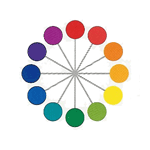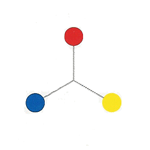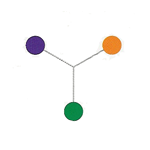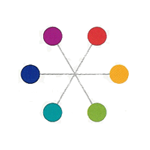Colour Assignment
This paper was written by Joe Hallock in 2003 and was the final deliverable for his undergraduate thesis at the University of Washington. New Media Communications 498.
This paper was is part of a research project with the goal of discovering cultural similarities (and differences) based on color association, preference, and internet activities. I posted a survey in late January 2003 with the goal of obtaining 500+ results. My initial hope was that with 500 responses there would be enough data from cultures outside the United States that the comparison of two or more cultures would be possible. When I closed the survey in early March 2003 I had only gathered 232 results (79.3% coming from the USA and the other ~20% divided amongst 21 other countries).
With a noticeable lack of international data, the aforementioned cultural comparisons were not justified. Moreover, the time constraints of a short winter quarter at the University of Washington have provided sufficient motivation to alter the focus of my research.
Cultural similarities and differences will not be included in this project (although I hope that someday…someone might pick up where I left off); nevertheless, the research focuses on four sections: First, words like trust, quality, and desperation (to name a few) and the colors the participants associated with these words will be examined. The goal of this section will be to discover trends (or lack thereof) between a standard list of colors and a list of words that may (at first look) seem to have no association with any color. Second, correlations between the aforementioned color sets and published research on color preference are investigated. Related to this, the next section will examine color psychology and some possible reasons for the color choices by the participants. Examining differences, and similarities, between already published information and the survey results will help present a qualitative perspective of the data collected in the color questionnaire. The fourth (and final) step is to correlate these results to online activities. In the survey, questions regarding the importance of a variety of online activities (e.g. shopping & communicating, to name a few) were asked, and this part of the project will focus on possible color combinations to help designers make better color choices for using, or not using, specific colors.
Figure 2.1 – color wheel 1
Read me
Unlike most formal academic research projects, this study is published as a web site. A web site can reflect the qualities found in a traditional research paper (e.g. an introduction, methods, results, parenthetical references, etc.) as well as the qualities of a dynamic document. This research project allows you to navigate through the document using several paths. If you wish to navigate the document in a non-linear fashion you can use the navigation buttons at the top of each page to jump to any of the sections. If you wish to read this study in a linear fashion you can use the “Next” and “Previous” buttons at the bottom of each page. Using these buttons will take you (in order) through the entire project much like turning the pages of a book.
If you have any questions, see any mistakes, or just want to communicate with me, you can reach me through my contact form.
Navigation
Color education
Color is generally defined as the characteristic of any object that’s described in terms of hue, lightness, and saturation. In 1666 Sir Isaac Newton, (Mr. Gravity) through experiments with a prism, laid a scientific foundation for understanding color. Newton showed that a prism could break up white light into a range of colors, which he called the spectrum.

Figure 1.1 – Visible Spectrum
Newton noted that the spectrum was continuous, but decided to use seven color names (red, orange, yellow, green, blue, indigo, and violet) by analogy with the seven notes of the musical scale. (Britannica: “color“) Although Newton stated that there were seven colors in the spectrum, he realized that colors other than those in the spectral sequence do exist, but noted that:
All the colors in the universe which are made by light, and depend not on the power of imagination, are either the colors of homogeneal lights (i.e., spectral colors), or compounds of these. (Britannica: “color“)
There are three categories for color types. First, primary colors consist of red, blue, and yellow. Combinations (or as Newton put it “compounds”) of these fall into the other two categories: secondary colors and tertiary colors (Color Harmony 16).
Britannica Online notes that there are three attributes that sufficiently distinguish one color from all other perceived colors. First, the hue is that aspect of color usually associated with terms such as red, orange, yellow, and so on. Second, saturation (also known as chroma, or tone) refers to relative purity. When a pure, vivid, strong shade of blue is mixed with a variable amount of white, weaker or paler blues are produced, each having the same hue but a different saturation. Lastly, light of any given combination of hue and saturation can have a variable brightness or intensity, which is dependent on the level of energy present (Britannica: “color“).
Chromatic, nonchromatic, and achromatic colors are visible to the human eye. Chromatic colors are the ones defined by Newton (e.g. red, indigo, yellow). Examples of nonchromatic colors are brown, pink, and magenta. Achromatic colors are applied to black, grey, and white. Britannica Online states that according to some reports, humans can distinguish some 10 million colors, all of which derive from two types of light mixture: additive and subtractive. Additive mixture involves the addition of spectral components and subtractive mixture concerns the subtraction (or absorption) of parts of the spectrum (Britannica: “color“).
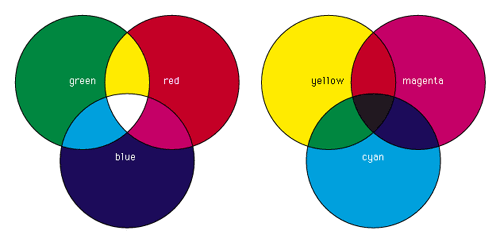
Figure 1.6 – Color Mixture
The three additive colors are red, green, and blue. By additively mixing these colors in varying amounts almost all other colors can be produced. Moreover, when the three primary colors are mixed together in equal amounts white is produced.
Subtractive color mixing involves the absorption and selective transmission or reflection of light. This usually happens when mixing colorants like pigments or dyes or when colored filters are used to cover a beam of light (Britannica: “color“).
Light
In the field of physics, color is associated specifically with electromagnetic radiation of a range of wavelengths visible to the human eye. The radiation of these wavelengths comprises that portion of the electromagnetic spectrum also known as the visible spectrum (i.e. light) (Britannica: “color“). Light, a small piece of the electromagnetic spectrum is the only visible form of electromagnetic radiation. Light has common characteristics with both waves and particles. It can be thought of as a stream of minute energy packets radiated at varying frequencies in a wave motion (Britannica: “color“).
A wavelength (the distance between corresponding points of two consecutive waves) is often expressed in units of nanometers (or 1 nm = 10^-9 meters). The wavelengths that make up visible light range from about 400 nm at the violet end of the spectrum to 700 nm at the red end. In an interesting side note, the limits of the visible spectrum are not exact for the human race. All humans have different exact upper and lower limits within the spectrum. As wavelengths get shorter the spectrum extends to include ultraviolet and continues through X-rays, gamma rays, and cosmic rays. As wavelengths get longer infrared rays (which can be felt as heat), microwaves, and radio waves are included in the spectrum (Britannica: “color“).
Measuring color
The measurement of color is known as colorimetry. It is difficult to describe the color of a specific spectral energy distribution because the eye perceives only a single color for any given energy distribution. So, to measure color it is necessary to express color measurements using a perception-related method. One method is called the tristimulus system. This system is based on visually matching a color under standardized conditions against the three primary colors (red, yellow, and blue). The three results (called tristimulus values) are expressed as X, Y, and Z respectively. Such data can be graphically represented on a chromaticity diagram (see figure 1.7)(Britannica: “color“).
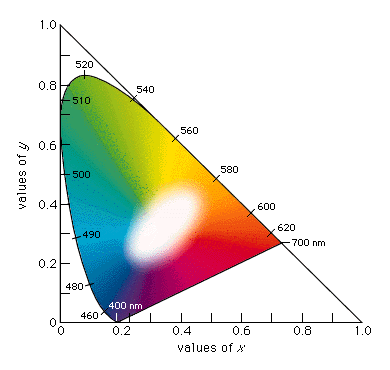
Figure 1.7 – Chromaticity Diagram
This diagram is based on the values of x, y, and z (where x = X/(X+Y+Z), y = Y/(X+Y+Z), and z = Z/(X+Y+Z)). Furthermore, because x + y + z = 1, if two values are known, the third can always be calculated and the z value is usually omitted. The x and y values together constitute the chromaticity of a sample (Britannica: “color“).
Navigation
Methodology
Participants
The study includes results from 232 people from 22 countries. The mean age of this group is 30.34 with the youngest being 15 and the eldest being 81. For the purposes of this study, 6 age groups were established: 1-18, 19-24, 25-35, 36-50, 51-69, and 70 and older. Please see figure 3-1 for a graphical representation of the number of participants in the aforementioned age groups.
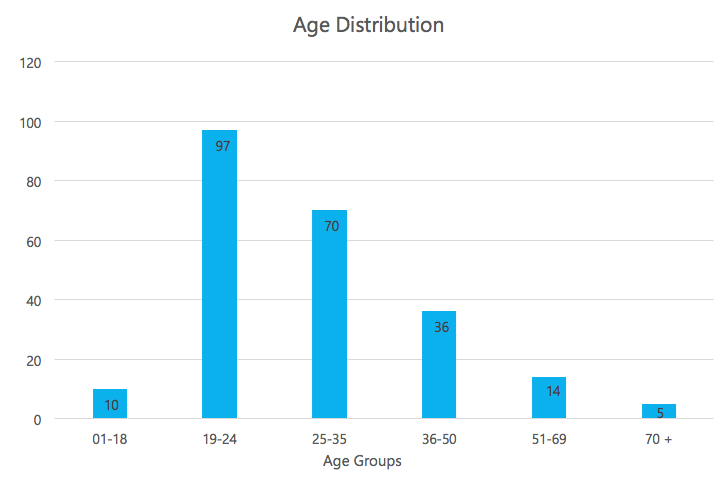
Figure 3.1 – Age groups
Both sexes were represented in this study. Females accounted for 144 survey results and males accounted for 88. The unequal distribution between the sexes relates to the procedures for presenting the survey to the public. (see the “Procedures” section below for more details)
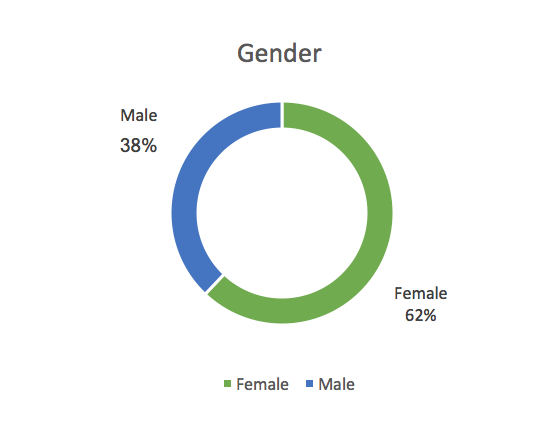
Figure 3.2 – Gender
The survey
The survey consists of 28 questions. The first three ask for geographic, age, and gender information. Questions 4-15 ask for color association information. All the color association questions require that the participant associate something to one of the following colors: Black, Blue, Brown, Green, Grey, Orange, Purple, Red, White, or Yellow. The colors were listed in alphabetical order and included a small example of the colors in question. The aforementioned colors are listed in Osgood’s atlas of affective meaning as colors that carry a high affective value (Cross-Cultural Universals of Affective Meaning). Questions 16 and 17 ask the participant to give their favorite and least favorite color of the colors listed (same colors as questions 4-15). And the last set of questions (18-28) ask the participant to rate from 1 to 5 the frequency they use (or perform) one of the listed specific Internet activitites. A score of 1 correlates to not performing that activity at all and a score of 5 correlates to performing that activity “all of the time.”
The Questions included in the Survey:
-
What country best represents your culture?
-
What is your age?
-
Gender
-
Which do you think best represents something cheap / inexpensive?
-
Which color do you think best represents reliability / dependability?
-
Which color best represents trust?
-
Which color best represents security?
-
Which color best represents speed?
-
Which color best represents fun?
-
Which color best represents high-quality?
-
Which color best represents high-technology?
-
Which color best represents loneliness / desperation?
-
Which color best represents fear / terror?
-
Which color best represents disease / health problems?
-
Which color best represents courage / bravery?
-
Which is your least favorite color?
Please rate from 1 to 5 the frequency with which you perform the following activities. 5 is very often, and 1 means that you don’t perform this activity at all.
Number code:
1 = “Not at all.”
2 = “Very rarely”
3 = “Sometimes”
4 = “Often”
5 = “All the time.” -
Shopping
-
Communicate (e-mail, chat, message boards, etc.)
-
Research (work / school)
-
Selling goods (e.g. ebay.com)
-
Get the latest news
-
Get the latest weather report
-
Play games
-
Download and/or listen to music
-
Download and/or watch movies
-
Express yourself (visual art) – (e.g. display art, photography, etc.)
-
Express yourself (written word) – (e.g. stories, poetry, etc.)
Pretest
A short pretest took place from January 24th to January 30th. The web form was tested in multiple browsers (e.g. Microsoft Internet Explorer 4.0, 5.0, 6.0 (all for Microsoft Windows (version 5.0 for Mac), Netscape 4.7, 6.x, and 7.x for Microsoft Windows, Red Hat Linux, Phoenix .5 for Microsoft Windows and Linux platforms, and Safari Public Beta v60 for Apple computers.
The web form was also tested under multiple submission conditions. That’s when two people submit results simultaneously. This was to ensure that the data submitted would collect without error under moderate traffic. Once the form was working properly, the questions were presented to a small group of people. Some minor changes were made to correct errors and to better word questions (e.g. changing the first question from “What country are you from?” to “What country best represents your culture?”). Because this project began with the intention to compare and contrast cultural differences and similarities between assorted culture groups, the choice to re-word some of the questions was necessary. Although the focus of the project changed (due to the type of results gathered) the results that were collected still supplied enough information to examine other interesting comparisons.
Procedures
Participants learned about the survey through several forms of online communication and verbal communication. The majority of the participants learned of the survey through email campaigns and posts on educational message boards. The link to the survey was also listed on multicultural public message boards as well as some international (culturally focused) message boards in Germany, Hong Kong, the Philippines, and Canada. This was an attempt to earn results from non-US publics. Aside from these online communications, several phone calls were made to colleagues in different vocational environments. These verbal advertisements were made during the last third of the survey’s public timeline. As stated on the homepage, the goal was to obtain 500 submissions and once failure of reaching that goal set in, phone calls were made to help supply enough results to top out above 200.
Navigation
Associations
About
Associations with color are defined, in part by Faber Birren (the author of Color Psychology and Color Therapy) by our senses, language, objects (or forms), and personality characteristics. color conveys moods which attach themselves to human feelings and our psychic make-up in an almost automatic fashion. This section presents the results of color associations and how they compare to other published studies.
Senses
In association with touch, colors appear warm, cool, dry, and wet (to name a few). Birren states that this reaction is inherent in the psychological make-up of most humans and that perhaps it’s built upon the association of earthly elements such as the sun, fire, water, sky, and even deserts (Color Psychology and Color Therapy, 168). Birren’s research gained support for the associations with ‘warm’ colors in 1940 by the Bulletin of the American Physical Society. S. M. Newhall, a researcher (and author) performed a study where he used 50 color samples to solicit responses from 297 observers to find out what colors best represented warm and cool. Newhall stated in his findings that, “the ‘warmest’ judgments show a minor mode in the violet…but a strikingly major mode in the red-orange region. The ‘coolest’ judgments exhibit no such marked mode, but range irregularly all the way from yellow through green and blue to purple.” (Color Psychology and Color Therapy, 168) Birren replied to this study by writing, “In other words, a color such as red-orange is perceived an unquestionable ‘warm’ by most persons. And greater latitude is shown toward “cool” hues, for green may express quality to some, blue to others, and violet to still other.” Later Birren states that because red will stimulate the autonomic nervous system, blue (or colors of similar energy levels) will tend to relax the nervous system. Thus the reason for a variety of colors with associations to ‘cool’ correlate to the number of colors in a specific energy range (Color Psychology and Color Therapy, 169).
Language
The English language abounds with expressions pointing to connections between colors and emotions. It is possible, for instance, to be purple with rage or green with envy. Sometimes one sees the world through rose-tinted glasses; at other times one is feeling blue (Color and Emotions, 1). Bradford J. Hall, the author of Among Cultures: The Challenge of Communications, defines language as, “Language is a rule-governed symbol system that allows users to generate meaning and in the process, to define reality.” By this definition alone, we can see that words that convey color bring meaning to the person deriving information from that word. The survey asked for the participants to correlate a specific color to types of words that don’t inherently assume to be linked to any specific color. These words include, trust, security, speed, and high-technology. The word trust is defined by the American Heritage® Dictionary of the English Language, Fourth Edition as a Firm reliance on the integrity, ability, or character of a person or thing. Below is a graphical representation of the survey results for the word ‘trust.’
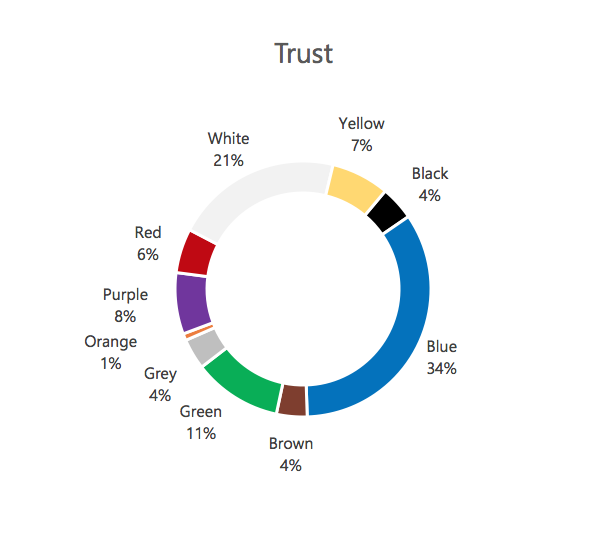
Figure 4.1 – Color associations with Trust
As you can see, the color blue gathered the most results from the participants. Birren correlated the color blue to the emotional feeling of sadness or depression (Color Psychology and Color Therapy, 170). This came about, Birren continues, because the color blue once referred to the insane, then expanded to symbolize mental depression in a general sense. A correlation between sadness and trust couldn’t be found, therefore, for the purposes of this study, this represents the first contradiction between published research and this survey.
The next word ‘security’ shares close relational ties (in terms of definition) to the previous word ‘trust.’ The American Heritage® Dictionary of the English Language, Fourth Edition defines security as Freedom from risk or danger; safety. One could say that without trust, security is hard to establish. Below is a graphical representation of the survey results for the word ‘security.’
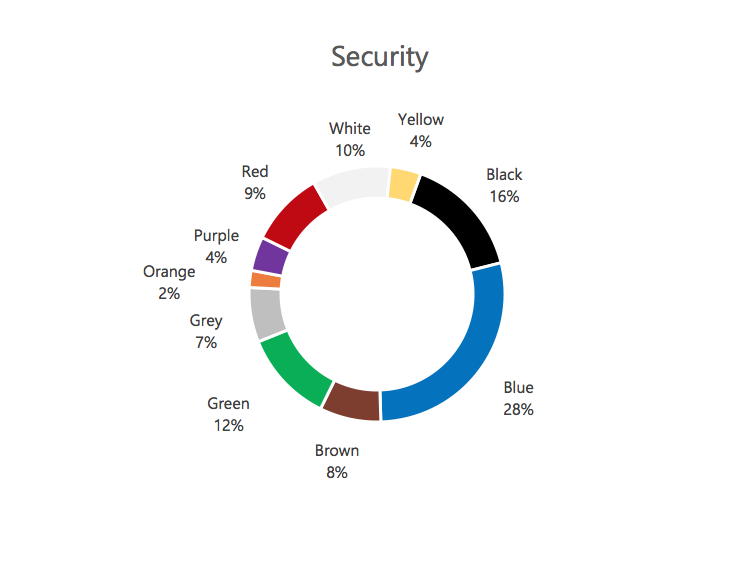
Figure 4.2 – Color associations with Security
‘Speed’ is noted by Birren as a subjective impression for the color red in his Modern American Color Association table (Color Psychology and Color Therapy, 143). Below is a graphical representation of the survey results for the word ‘speed.’
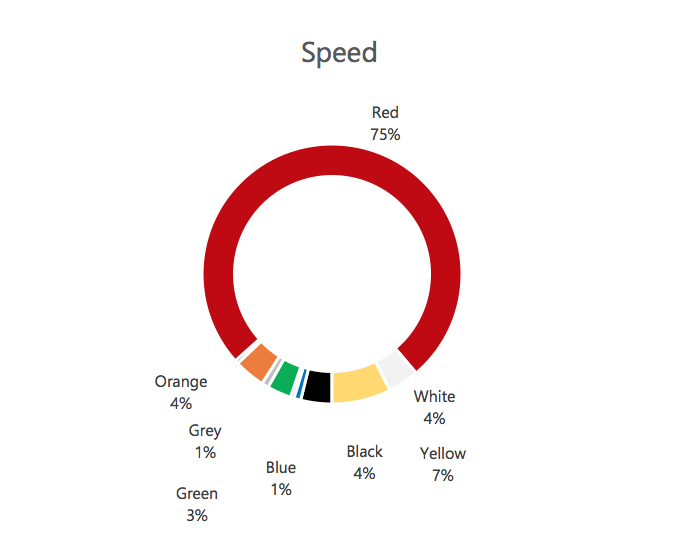
Figure 4.3 – Color Associations with Speed
It’s easy to see that red dominated the results of this question. Red is considered to carry the association of intensity, rage, rapacity, and fierceness (Color Psychology and Color Therapy, 143). Furthermore, R. Gerard, the author of Differential effects of colored lights on psychophysiological functions, maintained that “the color red and the emotion of anger both have an energizing effect that calls for actions and are therefore linked to each other.” Taking this statement into account, one could say that the word speed carries the same “call for action” that anger does (although the type of action may be different).
Objects
People tend to associate colors with the quality of objects they purchase. People will associate colors to objects that represent themselves like a new car, a home, or even a business suite. In the survey, several questions were asked with regards to colors and quality. The first question correlates color to the word(s) cheap and/or inexpensive. Below is a graphical representation of the survey results:

Figure 4.4 – Color Associations with Cheap / Inexpensive
It’s clear that colors like orange, yellow, and brown are heavily associated with something cheap and/or inexpensive. What’s interesting about this pie chart is that it closely correlates to the pie chart presenting the participants least favorite colors:
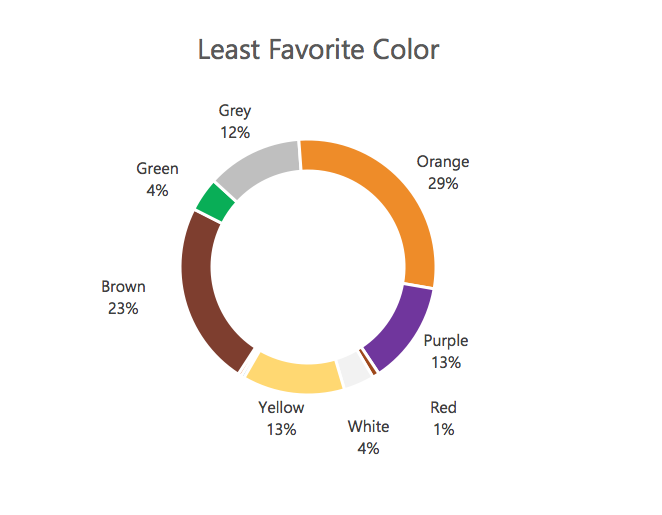
Figure 4.5 – Least favorite color
The next phrase is ‘High quality.’ See below for the graphical representation of the survey results:
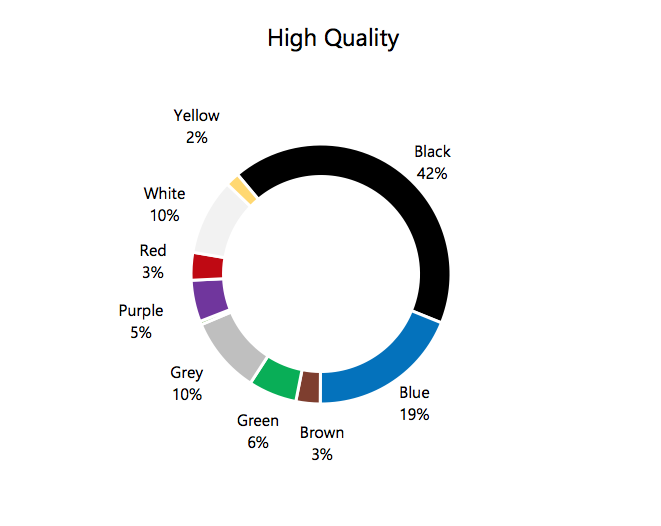
Figure 4.6 – Color associations with High Quality
As you can see, this is dominated by black and blue (together totaling 63% of the votes). This is another example presenting the differences between this survey and the results of Birren’s study. Birren states in his Modern American Color Associations table that Black represents spatial darkness, night, morning, funeral, depression, negation of spirit and death (Color Psychology and Color Therapy, 143). Although he may be correct, there’s no indication that black, to him, represents anything close to high-quality. There are two reasons for this: first, I believe he is only writing about abstract associations. Second, he mentions black with regards to the ease of seeing the object. He states that colors like blue, purple, and black cannot be clearly focused on at distances. Furthermore, the aforementioned colors (especially black) are very hard to see as the level of light is lowered.
High technology is the last phrase examined under the object heading. High technology is used because it carries (through mass media) characteristics of high quality. In addition to high quality, high technology seems synonymous with reliability and dependability. Below are two pie charts that present the survey results for high-technology and reliability / dependability.
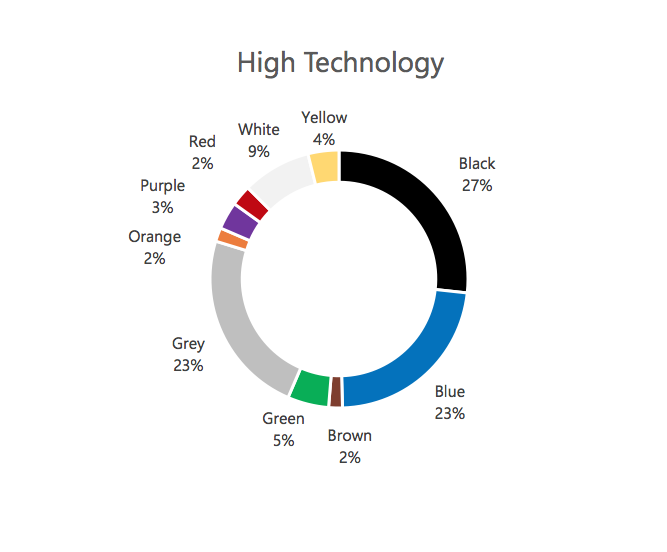
Figure 4.7 – Color associations with High Technology
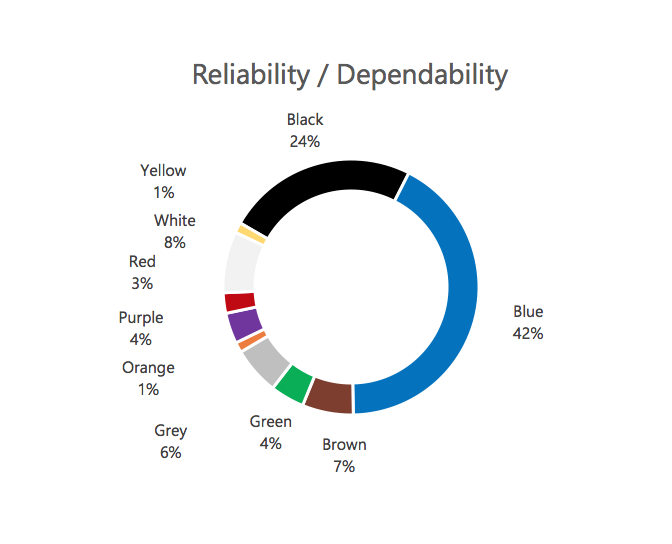
Figure 4.8 – Color associations with Reliability / Dependability
When reviewing the charts for ‘high quality,’ ‘high technology’ and ‘reliability / dependability’ one can see similarities. The two colors that most represent these three characteristics (according to the data) are black and blue.
Personality
Color and personality could be a research project on its own. That said, I think it’s important to touch on the survey data and document some clear discoveries, but not to dive head-first into an area that needs a lot of attention to be done well. Three questions were asked in regards to color and personality: What color would you associate with courage/bravery? What color would you associate with fear/terror? And what color would you associate with fun?
Courage / Bravery had an interesting result. See below for the results of the survey data:
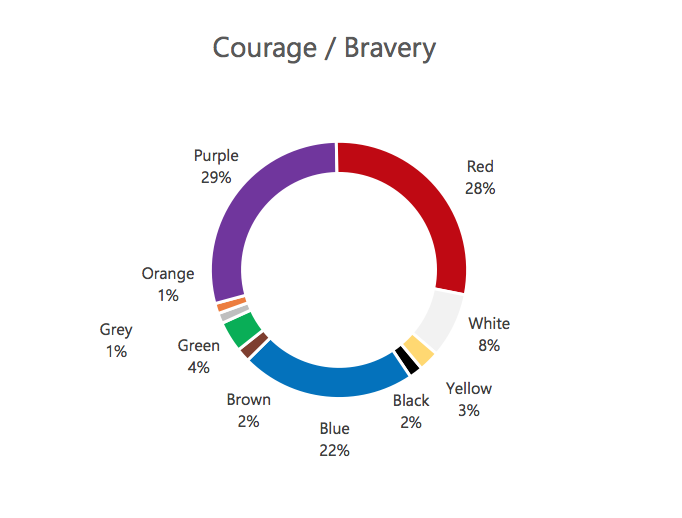
Figure 4.9 – Color associations with Courage / Bravery
As you can see the colors blue, red and purple are fairly even in terms of percentage of results. Birren notes that purple has a historically close association with dignity. The phrase courage / bravery carry a close association with the word dignity in the United States. Birren’s study associates blue to the American flag and the armed services. He also states that red associates with the American flag and the fourth of July (Color Psychology and Color Therapy, 143).
The next personality characteristic is fear and/or terror. See below for the results of the survey data:
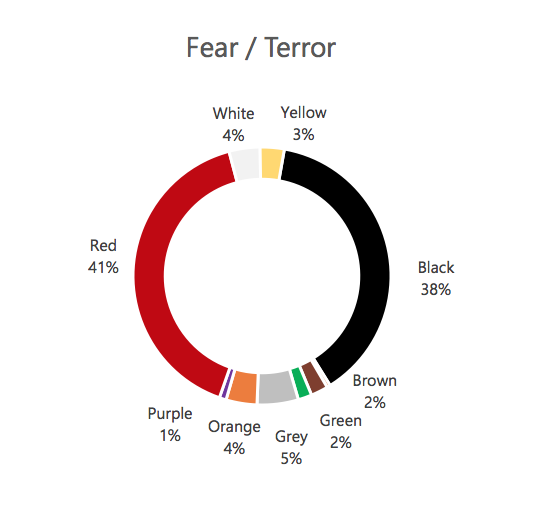
Figure 4.9 – Color associations with Fear / Terror
The colors red and black govern this pie chart. Combined they assume 79% of the vote and are fairly equal in proportion. Birren associates blood, fire, danger, rage, and fierceness to red, while at the same time associating mourning, funereal, ominous, deadly, and death to black (Color Psychology and Color Therapy, 143). It’s understandable that this pie chart contain the responses it does. One hypothesis for the 40-40 split in this section may have to do with the wording of the question. That is, one color may represent the word fear and the other terror. Since the two words were combined, there is no way to discover the reasoning without asking the simplified question.
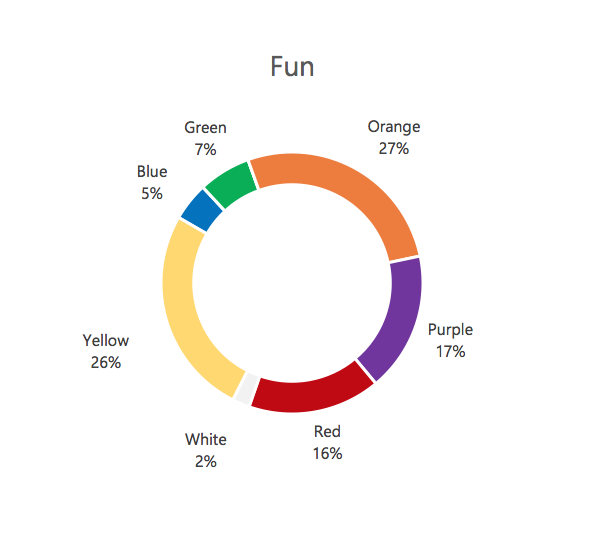
Figure 5.1 – Color associations with Fun
Associations like: exciting, mystic, jovial, cheerful, peaceful, melancholy, youthful correlate to red, purple, orange, yellow, green, blue, and white respectively in Birren’s study (Color Psychology and Color Therapy, 143). In Cailin Boyle’s book Color Harmony for the Web, Ms. Boyle states that use of primary colors help to produce lively and energetic web sites. The pie chart above contains all the primary colors and lacks both black and grey. Birren goes into more detail about this later in his book when he states, “The order in childhood, therefore, is red, blue, green, violet, orange, and yellow.” (Color Psychology and Color Therapy, 176). Although the results listed in the color survey data set don’t completely match the exact order of colors listed by preference, the colors noted by Birren for children are all present.
Navigation
Preferences
Favorite color
Our preference for a specific color can be related to how we feel in any situation, how we want to feel, and even how we remember certain experiences (to name a few). This section, which is closely associated with the previous section color Associations, presents the survey participants preferences and how they vary between age groups and gender. This first section examines the question of favorite color for all participants regardless or gender or age. Figure 6.1 below presents this information in graphical form.
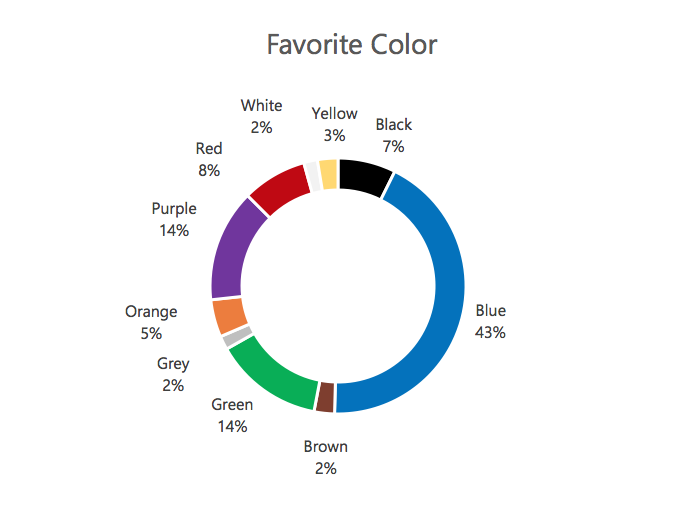
Figure 6.1 – Favorite Color
Blue, for this group of people, is the most favored choice of the 8 colors available. Blue is an interesting color in that people tend to choose it as a favorite, but it is usually associated with sadness and depression. Birren notes that blue is commonly associated with adjectives like cold, subduing, sober, gloom and fearfulness (Color Psychology and Color Therapy, 143). Although some studies have suggested that blue can represent feelings that are sad or not happy, people tend to like the hue of blue (and like colors) because they have a calming and relaxing affect.
Favorite color by gender
When this data is examined further and filters of gender and age are applied, some interesting results surface. The two pie charts below represent favorite colors of each gender.
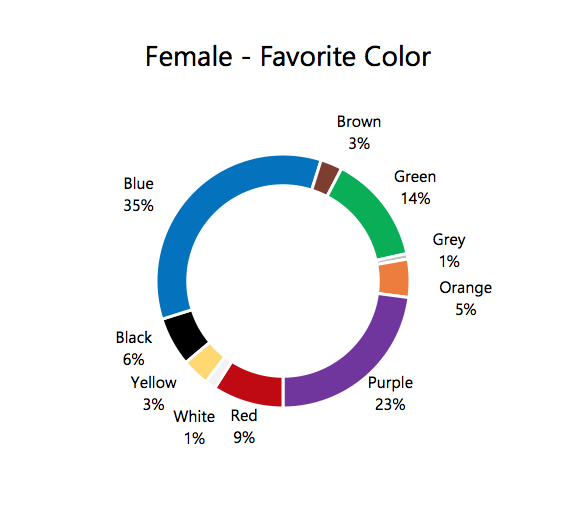
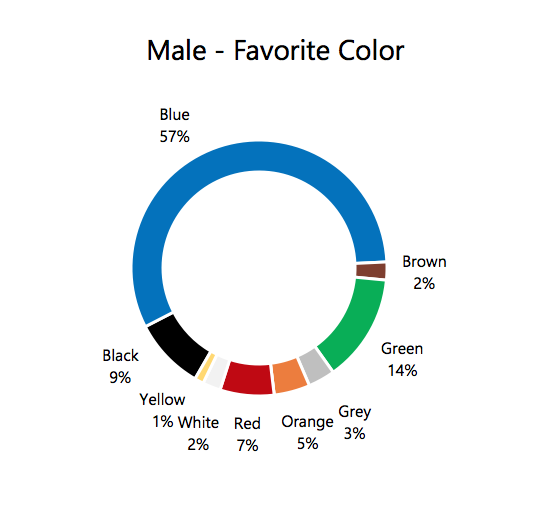
A review of color studies by Eysenck in the early 1940’s notes that St. George (1938) maintained that blue for men stands our far more than for women. Related to different colors, Eysenck’s study also found that the most significant gender difference is yellow being preferred to orange by women and orange to yellow by men. Natalia Khouw states, “this finding was reinforced later by Birren in 1952 who found men preferred orange to yellow; while women placed orange at the bottom” (The Meaning of Color for Gender, 1). Both these published results correlate to the survey results collected in this study.
Favorite color by age group
Color preferences differ by the age of the participant. Birren states in his book that blue and red maintain a high preference throughout life, but colors seem to drop down the list while other colors become more preferred. Yellow, for example, is well liked by children, but begins to drop away by people as they become adults. Birren states, “With maturity comes a greater liking for hues of shorter wave length (blue, green, purple) than for hues of longer wave length (red, orange, and yellow)” (Color Psychology and Color Therapy, 176). Below is a graphical representation of the survey results for a favorite color by age group.
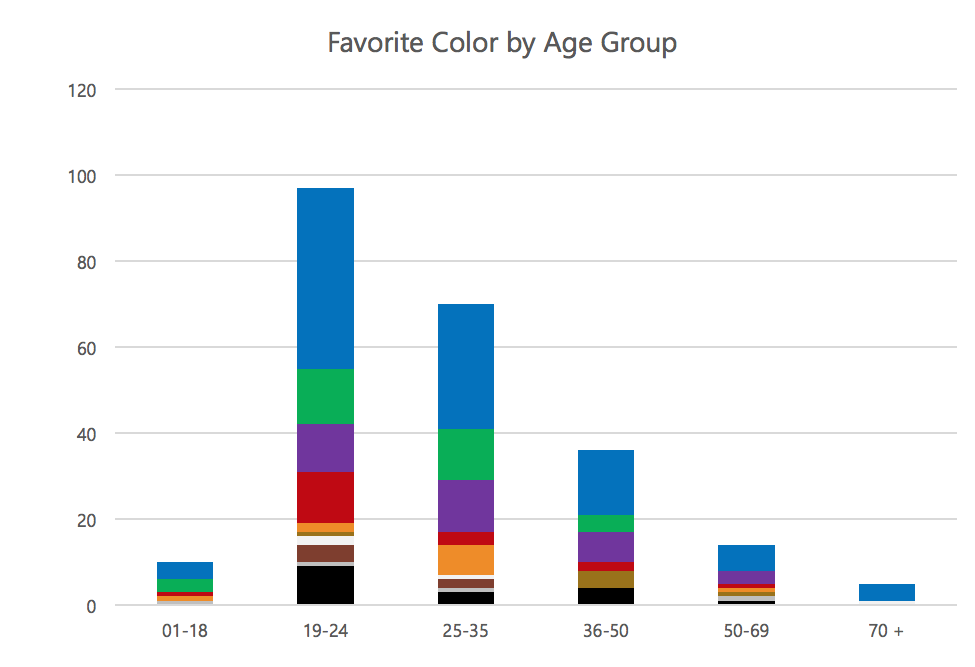
As you can see, blue, green, and purple make up the majority of responses. What’s interesting is the preference of green in the younger age groups and the preference of purple in the older age groups. One could say, by looking at this graph alone, that as people become older their preference for purple increases, while their preference for green decreases. Previous academic or research publications regarding this specific anomaly were not found during this project so the ability to compare and contrast these results with other results isn’t possible at this time. M. M. Terwogy and J. B. Hoeksma did a research study on colors and emotions with regards to preferences and combinations and they noted that as people get older, their preferences are likely to change as a result of social and cultural influences. They state, “As children grow up they learn that the expression of anger is often punished. They also learn that the color black (within Western culture) is associated with mourning.” (Color and Emotions, 7) They also state that the effects of color preferences are still present at later stages of life, but these preferences are outweighed by other (as yet unidentified) factors (Color and Emotions, 16).
Least favorite color
The least favorite color graph (shown below) was mentioned on the “color Associations” page along with what people tend to associate cheap and inexpensive. Below is a graphical representation of the survey results for least favorite color for all ages and both sexes.
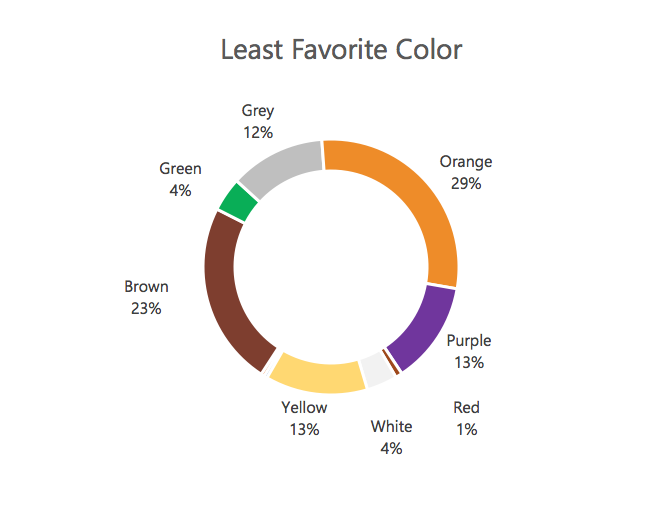
As you can see orange, brown, and yellow comprise the majority of responses. As you’ve already read, yellow (according to Birren) tends to drop from preferred to disliked as a person grows older. Also, Birren stated in 1951 that women tend to put orange at the bottom of their preference list. Brown, being a darker hue of orange may share some similarities with orange. An interesting detail about orange is the love / hate relationship people have with it as a color. According to the survey results, orange took 28% of the votes when associated with “Fun.” Also, according to Birren the adjectives that his participants gave to orange are: bright, luminous, glowing, warm, metallic, autumnal, jovial, lively, energetic, hilarity and exuberance. All of these adjectives, to me, seem positive. One hypothesis could be that the dislike of the color orange is of stylistic consequence. That is, orange may be going through a period of being out of style, at least in comparison to blue or green.
Least favorite color by gender
The two pie charts below represent favorite colors of each gender.
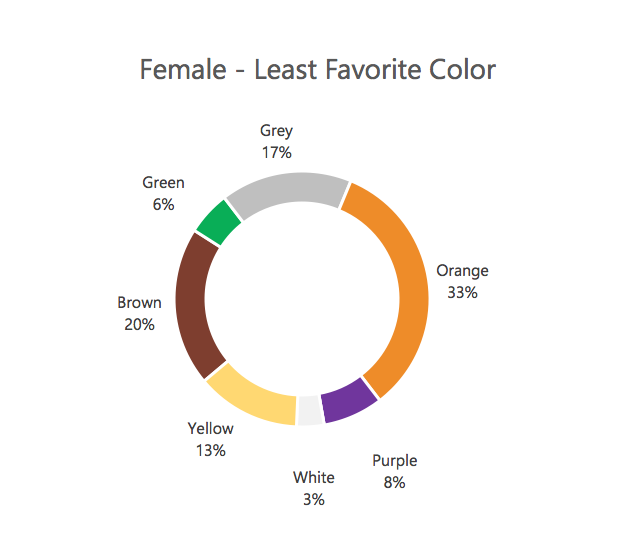
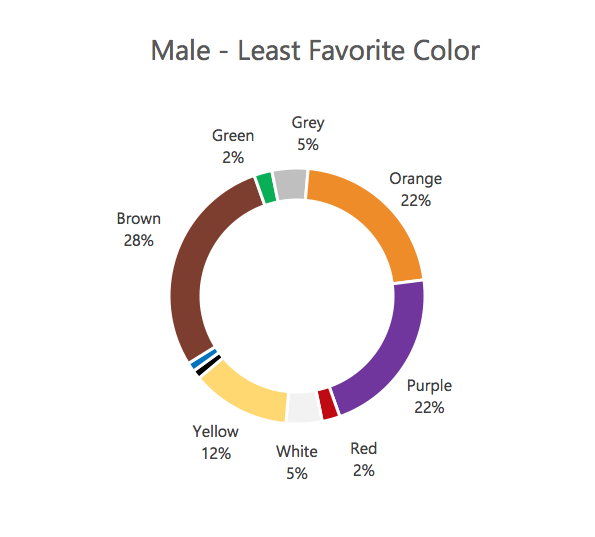
The aforementioned issues with orange, brown and yellow are supported by the pie charts for both Females and Males. The male participants gave 22% of their vote to purple which I found interesting because 20.4% of males stated that purple represented courage and bravery. This shows some inconsistency between the members of the Male participants. Women, on the other hand, only gave 8% of their vote to purple as their least favorite color. And 34.3% of women associated purple with courage or bravery. This gender difference is interesting and I believe it’s caused by cultural changes in color association. Birren wrote his book in 1951 and then revised it in 1962; he notes that the participants in his study associated dignity as one of the adjectives in defining purple. This may be related to the “Purple Heart Medal” which is given by the US Military to any member who is wounded or killed in the line of duty.

Least favorite color by age group
In the “Favorite color by Age Group” section above, I wrote about Birren’s comments about age and color. Subsequent to the bar chart below, I examine this studies results with Birren’s notes regarding age and color.
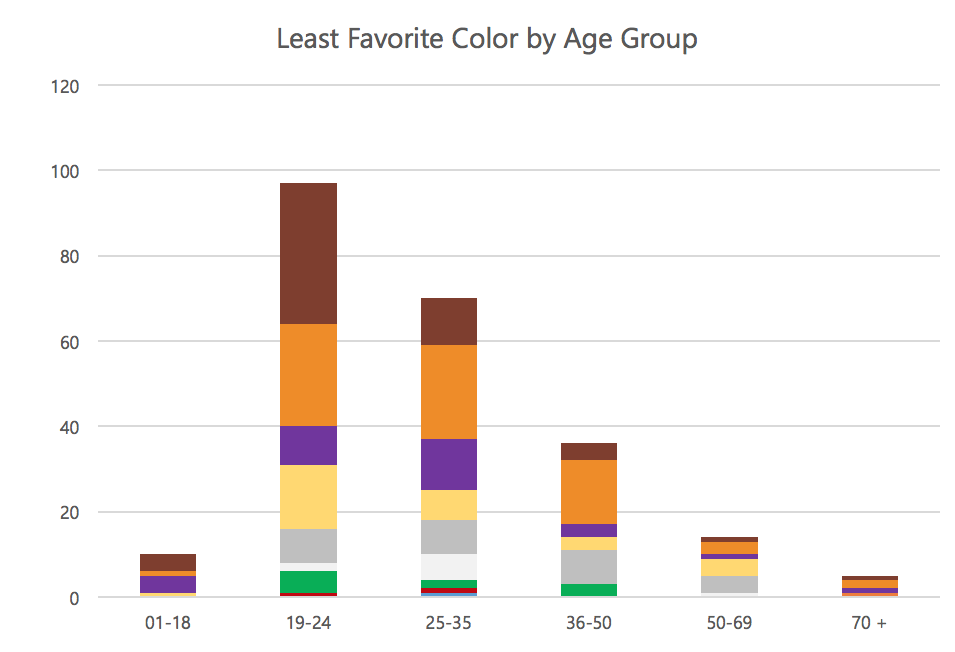
Birren seems to be correct about the color orange and its lack of popularity among older people. The bar chart shows orange increasing as part of the whole throughout the age groups of the participants. This survey’s results regarding the color yellow also correlate well with Birren’s data. As you can see, yellow slowly becomes less popular as age increases. (Note – the age group of 70+ participants only consists of 5 people. That might be why the graph seems to lose consistency near the upper age groups.)
Navigation
Psychology
Color and the mind
According to Britannica, the most important aspect of color in daily life is probably the one that is least defined and most variable. It involves aesthetic and psychological responses to color and influences art, fashion, commerce, and even physical and emotional sensations (Britannica: “color“) . Before we go into details about color psychology it’s important to understand that the psychological perception of color is subjective, and only general comments about its characteristics and uses are going to be made.
The first step is to note that colors are not universal to all humans in all cultures. Some languages don’t have specific words for green, blue, yellow or orange. In a related example, Eskimos use 17 words for white as applied to different snow conditions, where in the Northwest United States there are only 4 or 5. Like color terminology, color harmony, color preferences, color symbolism, and other psychological aspects of color are culturally conditioned, and they vary considerably with both place and historical period (Britannica: “color“). Another example of cultural difference could be the colors that are associated with mourning. In the United States, black is associated, but in other cultures around the world colors like white, purple, and gold are used during the mourning period (Britannica: “color“).
color symbolism is important in art, religion, politics, and ceremonials. Symbols that carry strong emotional connotations can affect color perceptions so that, for example, an apple or heart shaped figure cut from orange paper may seem to have a redder hue than a geometric figure cut from the same paper because of the specific psychological meaning that is associated with the shape (Britannica: “color“).
Factors like age, mental health, and mood affect the colors we see. People who share distinct personal traits then to share color perceptions and preferences (Color Psychology and Color Therapy, 176). For example, people with schizophrenia have been reported to have abnormal color perception and even very young people (who are learning to distinguish colors) usually show a preference for red or orange (Color Psychology and Color Therapy, 168). Furthermore, it has even been suggested that specific colors can have a therapeutic effect on physical and mental disabilities (Britannica: “color“).
A researcher named Gilbert Brighouse conducted a study where several hundred college students were tested to determine if their reaction times would differ depending on the color of light they were under. He found that the reactions of the students were 12% faster than normal under red light, while green light retarded their responses (Color Psychology and Color Therapy, 144). By this thinking, it could be said that humans are more likely to respond quicker under bright light than under dim light. D. B. Harmon stated in 1944 that most living things tend to orient themselves toward light or toward brightness. Also, as the energy of stimulation goes up, response tendency goes with it. In his opinion, therefore, bright environments will condition the organism for what he calls avoidant (big-muscle) activity (Color Psychology and Color Therapy, 144). This suggests (to Birren) that brilliance of light may hinder more sedentary tasks or mental activity. Birren concludes by stating, “Activities of a muscular nature are better performed in bright light and amid bright surroundings. Exacting mental and visual task are better performed with softer and deeper colors in the environment (though with ample illumination over the task) (Color Psychology and Color Therapy, 144).
Birren, who I’ve referenced throughout this study, writes two very interesting sections in his book that relate to the psychological effects of red and blue. Birren writes about the much quoted work of Ludwig and Von Ries and their research regarding the growth of rats under red and blue light. The rats that grew under the blue light developed at the same pace as rats that grew under normal day light. However, the rats that grew under the red light started out slow, and then exceeded the weight of the blue light rats. Another researcher named Ellinger points out, “Following exclusion irradiation with red light, young mice eventually die, apparently due to vitamin deficiency.” (Color Psychology and Color Therapy, 168)
In his notes about blue light, Birren states, “To some extent blue light is antagonistic to red. It is said to promote oxidation in the tissues and to retard hormonal activity. It has little effect upon the skin but is slightly germicidal. It would seem only logical that antiseptics meant to be applied to the skin should be blue, not red or brown, in order to assure the absorption of red radiation.” (Color Psychology and Color Therapy, 128) Because I don’t have a background in science I am unable to identify the accuracy of Birren’s last statement. I think that this would be a good topic for future research if someone were so inclined to take it on. From this information, Birren notes that red will stimulate the autonomic nervous system, while blue will tend to relax it. The equilibrium of the body, pulse rate, heart action, respiration, nervous tension, and even digestion will all be affected by both red and blue light (Color Psychology and Color Therapy, 147).
The last part of the color psychology section will focus on time, length, and weight estimations by humans under the influence of different colors. According to Goldstein (a researcher named in Birren’s book), red light is likely to be a factor in overestimating time. Conversely, green and blue tend to be a factor in time being underestimated. By this thinking, cool hues might be the best where routine and monotonous tasks are performed, such as in offices and factories. Warm hues would be suitable for living rooms, restaurants and cocktail lounges – where time in apparent “slow motion” might be more pleasurable (Color Psychology and Color Therapy, 146). Related to this, the length of an object (or how we perceive the length of an object) is less correct in red light, and more correct under green and blue lights. In other words, things are likely to seem longer and bigger under warm light and shorter and smaller under cool light. Finally, weight is judged as lighter under bright lights and heavier under darker lights.
Navigation
Online activities
Activities and color
In the survey, questions regarding the importance of a variety of online activities (e.g. shopping & communicating, to name a few) were asked, and this part of project will focus on possible color combinations to help designers make better color choices for using, or not using, specific colors. To begin, let’s take a look at the reasons people use the Internet. The graph below presents the survey data for the questions regarding the importance of online activities. The scores in this graph are averages of all the results with no filters applied to age groups or gender.
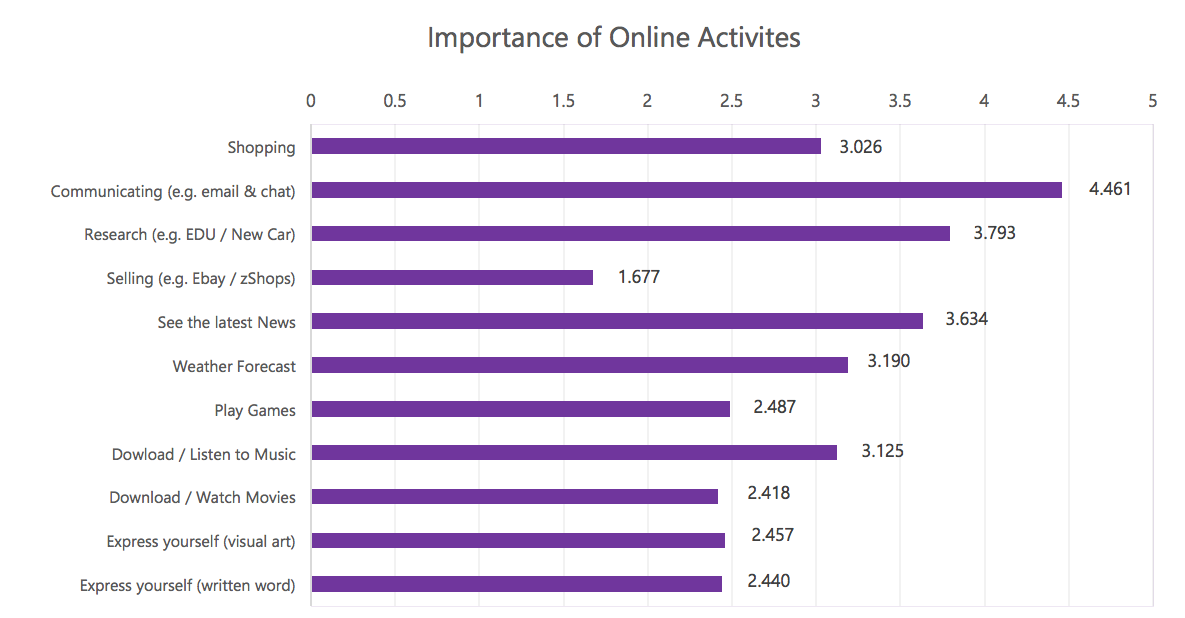
As you can see, shopping, communicating, research, news, weather, and downloading music are the highest in the ranking. To tie in the discoveries listed in the preceding pages, I’m going to suggest two scenarios where an organization needs a new color scheme for their web site. The first site is an online store that caters to people who purchase children’s toys and gifts. This e-commerce store only makes a small profit on each transaction, so they need to move a lot of product to maintain financial buoyancy. The second site is designed for women with breast cancer. The site is owned by a non-profit company and is made available for anyone who wants to learn more about the disease, donate money to the cause, and/or communicate with others who have suffered, or are currently suffering, from the ailment. Although both organizations use the Internet to communicate to their publics, their goals are completely different.
The toy store
As we learned in the associations section of this report, people associate several colors to the word fun. Most of which are the primary and secondary colors red, blue, yellow, green, purple, and orange. Cailin Boyle, who is mentioned in the education section of this site, states in her book Color Harmony for the Web that the use of bright and highly saturated colors can help make a corporate identity fun, accessible, and exciting (Color Harmony 130). Part of doing this would be to use colors that are bright and full of energy. Colors like red, orange and yellow all give off a high level of energy and would bring an exciting atmosphere to the project.
Alongside the need to produce a site that’s friendly, the online store needs to have a color combination that promotes a quick transaction. Red is shown as the major color choice when associated with speed on the color associations section of this site. Also, as stated in the psychology section, the color red is known to affect the mental processes of a human. Although I don’t know if this is the absolute truth, one could say from reading Birren that the use of red would help take some of the contemplation out of the decision. Getting people to find something and quickly make a purchase is the goal of this store. Boyle, in describing Neiman Marcus’s web site design stated that they used bright color palettes that create excitement about the new products…and their medium created a sense of ongoing newness critical for a successful e-commerce site (Color Harmony 44). Yellow is another color that can be relied on in this situation. Although children tend to like the color yellow more than adults do, the use of yellow is necessary to maintain a child-like theme. Although we may not be conscious of the popularity of this color and its dependence on age, we all know that children tend to enjoy bright and highly active colors.
Breast cancer awareness
The majority of people who have, or had, breast cancer are female and tend to be older than 30 years of age. These two criteria are fundamental when choosing a safe color scheme for a topic of great importance. Luckily, this survey consisted of 62% female participants. By looking at the favorite colors by age group, the courage / bravery pie chart, the fear / terror pie chart, and the fun pie chart we can get a good idea of what colors to use. To begin, the bar graph for favorite color by age group and the favorite color for female pie chart are listed below.


As you can see, the colors older females tend to favor are blue, purple and green. From the studies Birren performed, and written about in the associations section, the preference section, and the psychology section, blue is known for being a favored color, but is also associated with depression, gloom, and fearfulness (Color Psychology and Color Therapy, 143). Blue also tends to be a cold and unenergetic color. For these reasons alone, the heavy use of blue may be a poor choice. Green represents life, nature and restfulness, but also can be associated with guilt and disease according to Birren. Purple is often associated with dignity and courage, a combination of words that may give hope to those with cancer. Below is the graph depicting the survey results for courage and bravery.

As you can see red, purple, and blue all play a role in the representation of courage and bravery. Aside from courage and bravery, Red, according to the survey participants, is closely associated with speed, fun, and fear / terror. See below for the pie chart representing the votes for fear and terror.

Red might be a color to avoid for a project like this. The last thing we need is the users of a breast cancer awareness site feeling a sense of fear or terror. This leaves Purple as the best single choice for a color. Different hues of purple include pink and magenta and are currently included in many medical color schemes today (http://www.komen.org/bci/ for example).
Navigation
Conclusion
Wrapping up
This project started out with a goal to examine people’s associations with colors, where their color preferences are, and how these associations and preferences differ among age, gender and culture. After the survey was built and the responses gathered, a realization set in that my goal wouldn’t fully be satisfied. It was necessary to avoid the topic of cultural differences and similarities altogether. Although I was only left with gender and age, these two topics alone seemed to produce more questions than I could answer during this short 10 week quarter.
Although I feel that my research was satisfactory, I hoped to go into more detail with each topic. There are many opportunities for future research if someone were so inclined. Culture differences among participants would deliver some very interesting results. Color associations vary greatly depending on the culture. This can be taken a step further where the differences and similarities between groups of people who live in different geographical locations, but share a similar culture. For example, how do people in Alaska differ from people in Florida? How do people in Spain differ from people in Rio? One method could even use zip codes and examine differences among people in the United States and Canada. The one task that needs to take place before more research can begin is the collection of more data. With the aforementioned time constraint, my ability to collect a large sum of data was hindered. Another idea for possible future research could be the correlations between color and sound. In the research work I did I found large similarities between the feelings people have and the feelings they have around sounds and music. This might explain the popularity of music videos. I hope you enjoyed this project. If you come across any grammatical or spelling errors, or you see a reference that doesn’t seem correct, please contact me.

